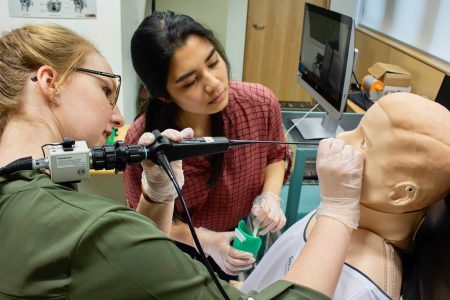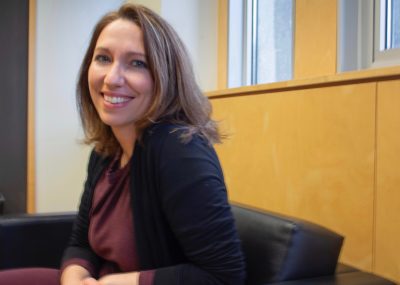
Second-year speech-language pathology students Sophie Palmer and Katrina Reyes practice their swallowing assessment techniques on SimMan – a high-fidelity mannequin.
Like most of her speech-language pathology classmates at the University of British Columbia, Sophie Palmer had some jitters about the possibility of threading a fibreoptic nasendoscope through someone’s nose to examine the pharynx, the cavity behind the nose and mouth.
Fortunately, she was able to practice on SimMan – a mannequin that can talk, breathe, sweat, cough, and even bleed.
Such simulators have become a common part of training for medical and nursing students, but UBC’s speech-language pathology program is the first in Canada – and one of only a few worldwide – to have a dedicated, high-fidelity mannequin for students to practice their techniques in the diagnosis and treatment of swallowing disorders.
“As students put the scope through the nose and into the pharynx, they’re able to monitor their progress by gauging how the mannequin responds — any number of physical reactions may indicate they need to adjust their approach,” says Stacey Skoretz, an Assistant Professor in the School of Audiology and Speech Sciences and Director of the Swallowing Innovations Lab at UBC. “With SimMan, we’ve been able to enhance the student’s education experience, by simulating real-world, clinical situations and designing novel, high-fidelity scenarios for swallowing and its disorders.”
A typical person swallows hundreds of times a day without thinking. But it often becomes a challenge for people with neurodegenerative disease, cancer of the head or neck, critical illness, or for those who have had a stroke.
“Swallowing is actually a very complex process,” says Dr. Skoretz, one of a handful of researchers in Canada specializing in swallowing disorders. “Learning how to assess, diagnose and treat swallowing problems — which affect millions of people around the world — is critical for our students’ success as future speech-language pathologists.”

Dr. Stacey Skoretz
Since SimMan’s arrival a year ago, Dr. Skoretz has not only programmed the mannequin to respond to different actions and diagnostic tools specific to a swallowing assessment, but has developed case-based swallowing simulations which use images and videos so students can see exactly what it would look like when a real patient swallows.
“What’s really great about the mannequin is that you can interact with it — and it will react differently based on the actions and decisions you make,” says Katrina Reyes, who, like Palmer, is completing the two-year speech pathology program this fall. “As a student, it’s been an amazing experience and teaching tool that has helped me to prepare for working as a speech-language pathologist.”
In the next few years, Dr. Skoretz hopes to use virtual reality to augment the students’ simulation experience, and to use simulation with other health professional programs at UBC.
“We want to create opportunities for inter-professional team simulations, where students in different disciplines can work collectively, learn from each other, and fulfill their vital role on the team,” Dr. Skoretz says. “Our ultimate goals are to enhance both student learning and patient care in the area of swallowing and its disorders.”